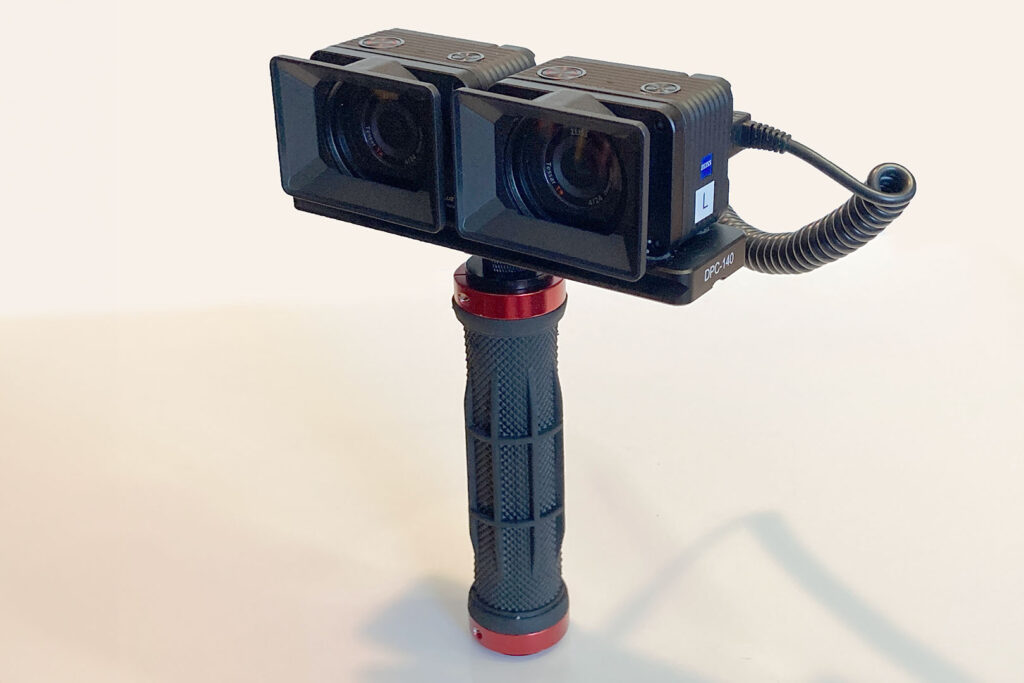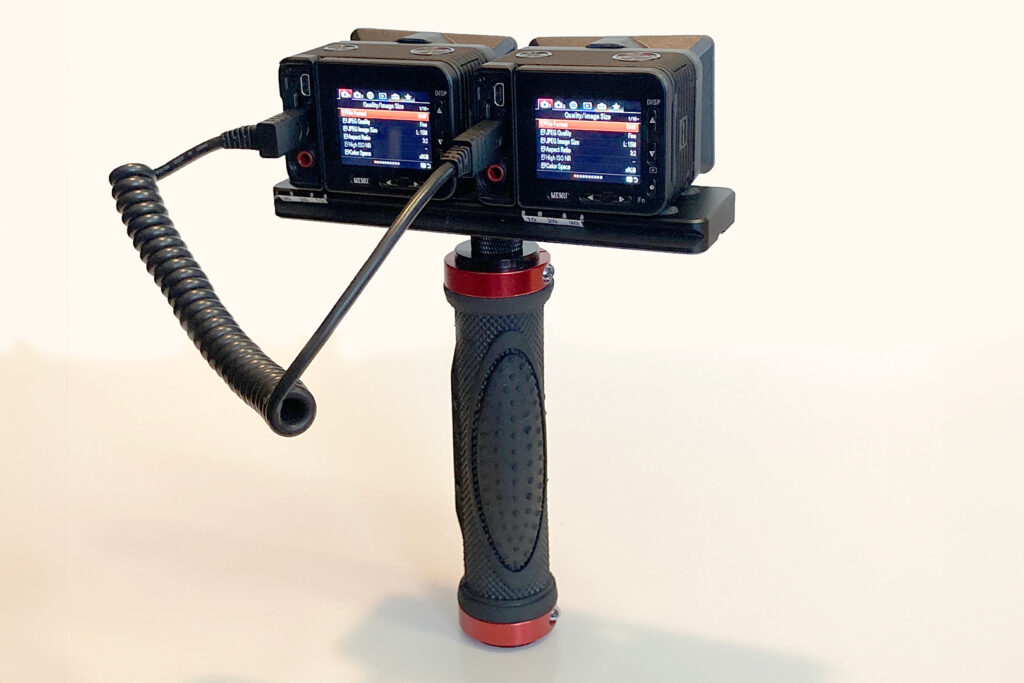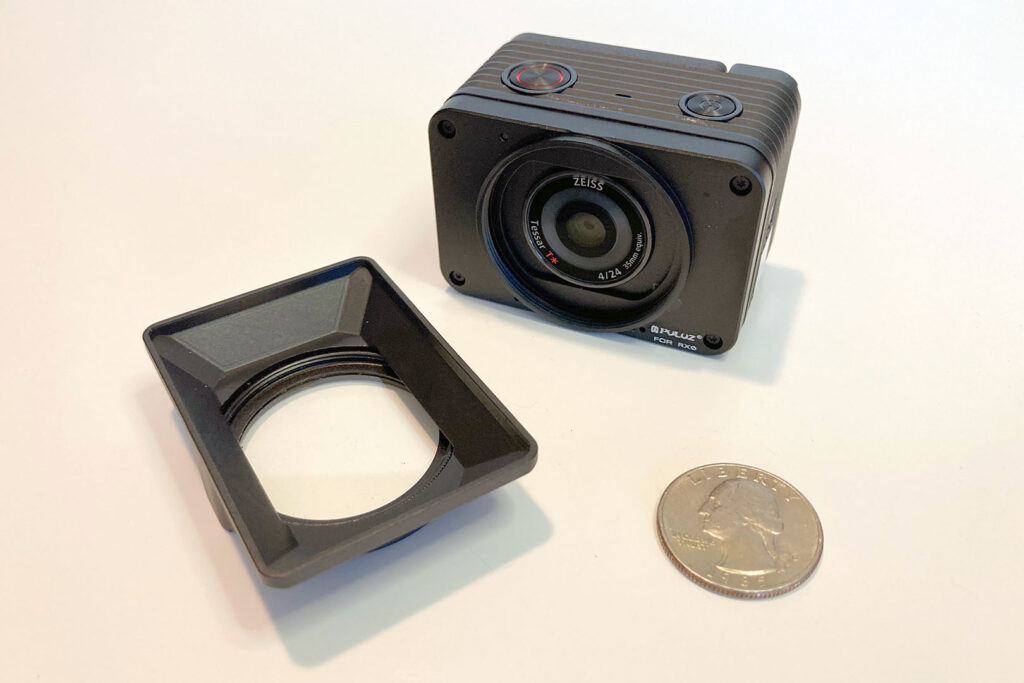
Stereographers must compromise when selecting cameras. With limited dedicated digital stereo cameras available, and the intricacies of synchronizing two cameras, finding the ideal setup can be challenging. Inspired by Harold Baize’s impressive Burning Man stereo photographs showcased at the New York Stereoscopic Association, I explored the potential of Sony’s RX0 II cameras. Here’s my experience.
About the Camera
Sony’s RX0 II, released in 2019, is a rugged mini-camera that’s designed with synchronization in mind. Sony calls it a “premium tiny tough camera.” The RX0 II resembles a GoPro action camera, but is optimized for both stills and video.The cameras’ blocky, diminutive 2 3/8” × 1 5/8” x 1 7/16” form is ideal for stereo, as the lenses can be spaced at an average interpupillary distance of 65mm (the closest they can get is about 60mm). The RX0 II is extremely portable at about 4 ½ ounces. The camera is capable of very fast shutter speeds (up to 1/32000) and impressive low-light sensitivity (a maximum ISO of 25,600) that open up new possibilities for stereo subjects. Paired for stereo photography, my RX0 IIs perform admirably, with some caveats.
Specs & Performance
I’ll focus on the RXO II’s still photography capabilities. The RX0 II is also a capable video camera, shooting HD video at up to 120 frames per second, or 4K video at 30 frames per second. I have yet to explore 3-D filmmaking with my rig, but look forward to experimenting.
The RX0 II is designed to be synchronized. Sony calls it “dual-camera shooting,” and with their optional Camera Control device, up to 100 RX0 IIs can be synced. When paired, pressing one of either shutter buttons will set focus and exposure for both cameras independently. I haven’t researched the synchronization accuracy of my RX0 II pair scientifically, but it’s good enough for most of my photography. Although rare, I have lost a few shots of very fast action due to synchronization lag, and am experimenting with slower shutter speeds to obtain more accurate synchronization when capturing fast motion.
Compared to more traditional cameras, the specifications of the RXO II are outrageous. A 1” sensor, larger than usual in small cameras, enables many of the RX0 II’s strengths. ISO up to 25,600 facilitates shooting in the dark. The fixed 4.0 aperture Zeiss lens with an f/7.9 focal ratio manages substantial depth of field without drastic barrel distortion. Other advanced features mirror those in DSLRs, likes continuous shooting, interval shooting, and bracketing. Focus and metering modes are also adjustable. ARW, Sony’s proprietary RAW file format, opens in Photoshop’s Camera RAW filter, Sony’s included Capture One Express photo editing software, and other applications (the camera also saves JPEG files). Shooting modes are Program Auto (configurable ISO and exposure), Manual (configurable shutter speed, ISO and exposure), and Sony’s own “Intelligent Auto” and “Superior Auto” modes that I avoid. A digital zoom is available in some modes.
The RX0 II is solidly built, with a crushproof “super duralumin” (aluminum) body. The camera is also rated as waterproof and dustproof, but not with the memory card/connector cover removed as I have done for easier access to the connections. The physical shutter button has good travel and feedback, and its size and position reduce the likelihood of confusing it with the smaller adjacent power button. Tiny menu text on the miniscule 1 ½ inch, high-resolution screen benefits from sharp eyes. The camera can also be networked and controlled through a tablet or smartphone app.
A battery charger is not included with the camera. Instead, charging is done in the camera with its USB 2.0 connection. Swapping and charging the camera batteries is straightforward. With my settings, I get about 4 hours of shooting from a pair of batteries. I purchased a second pair to keep me shooting all day.
While photo quality is just satisfactory compared to mirrorless counterparts with similar sensors, the RX0 II has its place, especially considering its unique synchronization abilities.
Operation for Stereographers
My stereo rig is made of two Sony RX0 II cameras, faceplate and shade accessories, a sync cable, a 5 ½ inch quick release camera plate, and a handle.


The sync cable resembles a regular micro USB cable, but is in fact a proprietary Sony Multi Terminal cable. These cables are rare, and not available in many lengths. Being proprietary means they are also pricey. That said, it’s worth buying the official Sony VMC-MM2 Release Cable. It’s well-made, and the coiled cable’s right-angle connector on one end helps with cable management. The VMC-MM2 comfortably stretches to about 14 inches without strain for hyperstereo. The USB 2.0 port that’s adjacent to the Multi Terminal port is for charging the batteries or transferring files.
Lens shades are a must. The flat glass faceplate of the RX0 II picks up glare and reflections. Third-party replacement faceplates with lens shade attachments solve this problem, but an improvised cardboard shade can also suffice. I use a replacement faceplate that also accepts 37mm filters, and I use UV filters to protect the lenses. The RX0 II lenses are not interchangeable. Lens mount adapters for 37mm filter attachments are available, but expect distortion and vignetting from any lens you attach to one of these gimmicks.

Adapting to the RX0 II involves reimagining shooting techniques. Its sensitivity and speed redefine photo capturing. The camera’s fast shutter speeds effectively freeze motion in stereo, and over-the-top light sensitivity encourages indoor shooting without a flash. While the RX0 II has a manual mode to select shutter speed, I favor the Program Auto mode. I usually shoot outdoors in daylight, and aim for fast shutter speeds and deep focus. To achieve this in Program Auto mode, I first set my exposure (-0.5 to -1 on bright afternoons, 0 on overcast days, early mornings, and late afternoons). I then set the cameras’ ISOs to a high value, between 640 and 1,000, even in bright sunlight. Program Auto fine-tunes the shutter speed based on the brightness of the scene, and can be expected to be fast. To increase or decrease the shutter speed, I adjust the ISO. Manual mode can be used to set the shutter speed, but I find the results are less consistent than with this technique.
I manually set my cameras’ white balance for consistent color across the two cameras. The tiny screens are impossible to view in bright sunlight. I use the “Sunny Weather” (extra bright) setting, which solves the problem while reducing battery life.
Conclusions
These imperfect cameras are now the only ones I shoot with, replacing my worn Fuji W3, my end-of-life Canon SD1000s paired with Stereo Data Maker, and my insufferable QooCam EGO. Their small size makes my rig extremely portable, and are versatile for creative lens spacing. They are as reliable as I expect from a Sony product, run cool, and synchronize easily. Despite their flaws, they are fun to use.
Links
Sony RX0 II Camera
https://www.bhphotovideo.com/c/product/1469682-REG/sony_dsc_rx0ii_cyber_shot_dsc_rx0_ii_digital.html
Sony VMC-MM2 Multi Terminal Cable
https://www.bhphotovideo.com/c/product/1393456-REG/sony_vmc_mm2_release_cable_for.html
Faceplate with Lens Shade
https://www.ebay.com/itm/394217199772
NP-BJ1 Battery
https://www.amazon.com/Wasabi-Power-Battery-DSC-RX0-DSC-RX0M2/dp/B0778D8QDY
Official Sony Web Page
https://www.sony.com/ug/electronics/cyber-shot-compact-cameras/dsc-rx0m2
